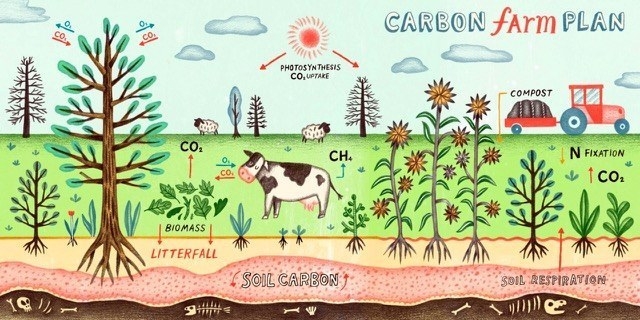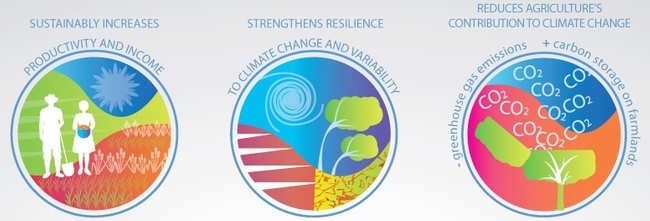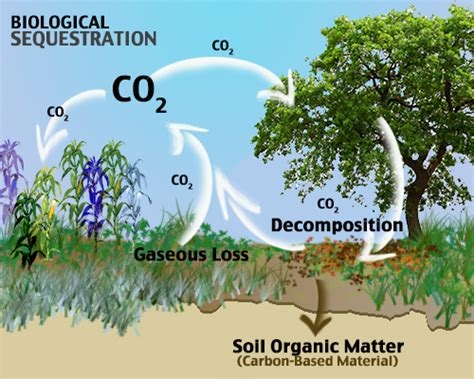- Author: Alli Rowe
Thanks to special guest author Shulamit Shroder for a glance at a Healthy Soils Program grant in action. Shulamit is Kern County's UCCE climate smart agriculture specialist.
Quaker Oaks Farm is a small nonprofit farm in Tulare County, near Visalia. About half of its 21 acres are devoted to restoring and maintaining a native wetland and riparian oak forest area. The rest is a diverse organic farming operation, with areas devoted to annual vegetable crops, grazed grasslands, and a small orchard.
As farm manager, Steven Lee applied for and received a Healthy Soils grant in 2017 to plant cover crops and hedgerows, apply compost and mulch, and establish a silvopasture area.
He believes that this investment in the farm's soil will pay off in the long term, so that the next generation can continue to enjoy the services provided by the nonprofit's complex landscape.
Between March 2018 and March 2021, the farm plans to:
- Plant cover crops on 4.5 acres
- Plant hedgerows on 0.3 acres
- Establish a 2.5 acre silvopasture area
- Apply mulch to 2 acres
- Apply compost to 6 acres
Benefits
Water usage: Dr. Lee reported that the mulch has helped keep young plants from wilting in the hot sun and that their overall water usage has decreased.
Energy usage: They have reduced their tillage operations, which has decreased their energy use and their carbon footprint.
Pests: Dr. Lee has witnessed an increase in beneficial insects since the start of the project, especially ladybugs. In 2018, the ladybugs did not migrate away from the farm during the hottest part of the summer like they had in previous years. The farm also did not have to spray organic pesticides in 2018, unlike in 2017. In addition, the increase in native pollinators should help to pollinate the fruit tree orchard, since the farm does not have its own beehive.
Disadvantages
Labor: Implementing these practices takes time, and Dr. Lee does most of the on-farm labor himself. He ended up prioritizing the Healthy Soils project over production during the past year, since the grant has offset his labor costs.
Learning curve: Determining optimal timing has been the steepest learning curve so far, such as figuring out when to plant the native hedgerow plants and when to replace the ones that died.
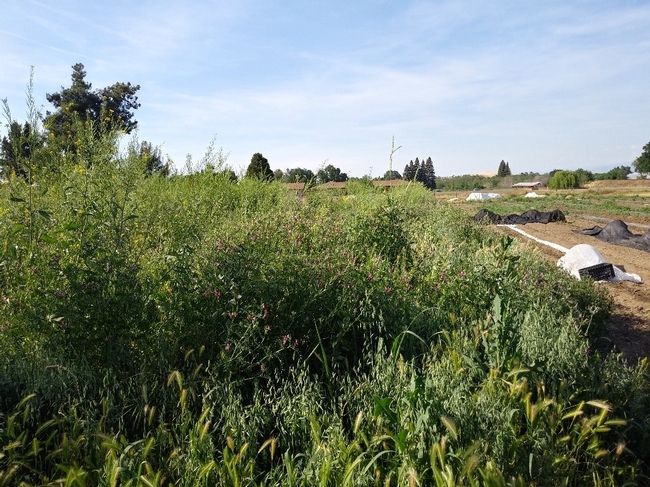
Climate smart agriculture encompasses management practices that increase soil carbon sequestration, reduce greenhouse gas emissions, improve yields and efficiencies, and promotes climate resilience. The California Department of Food and Agriculture (CDFA) supports three funding opportunities in climate smart agriculture: the Healthy Soils Program, the State Water Efficiency & Enhancement Program, and the Alternative Manure Management Program.
In a collaborative partnership, CDFA and UC Agriculture and Natural Resources have teamed up to support 10 community education specialists throughout the state to provide technical assistance and outreach for the climate smart agriculture programs. As one of these technical assistance providers, my role is to promote and support the adoption of these programs in Ventura County. If you are interested in working with me, please contact me at amrowe@ucanr.edu.
- Author: Alli Rowe
Petty Ranch, a story of cover crops in Ventura County.
“All of the lemon trees were dying.” Sigh. Another distressing story about agriculture in the face of climate change, rising land values, difficult economies, and soil degradation. Or is it? Chris Sayer, owner of Petty Ranch, walks me through his 50-acre property of figs, lemons, and avocados. In addition to his trees, Chris has a whole other system growing. Cover crops.
I am personally a huge fan of cover crops or green manure. Planting cover crops keeps the soil covered, which reduces the loss of topsoil to wind and rain. Additionally, cover crops are an inexpensive way to build soil carbon and improve soil structure. Depending on the cover crop chosen, root systems help penetrate and break up plowpan layers created from tractor compaction, increase water infiltration, reduce runoff, and improve nutrient cycling for cash crops. Many cover crop systems include legumes, which have the amazing power of fixing atmospheric nitrogen. In an association with bacteria, legumes “fix” nitrogen from the atmosphere into a biologically available form in the soil that plants can use. In this way, cover crops with legumes mixed in can increase nitrogen levels in the soil, allowing farmers to reduce fertilizer inputs.
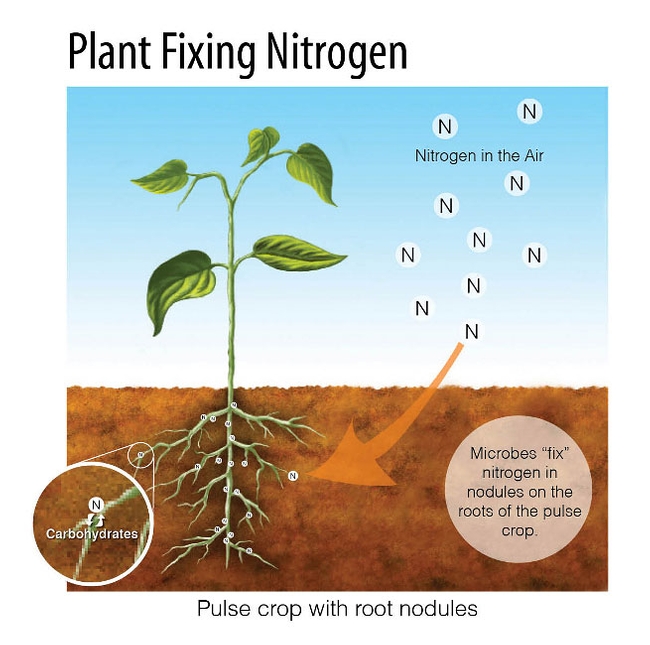
Back at the fig trees, Chris picks up a shovel. He easily scoops up a nice shovelful of soil, maneuvering the shovel into the earth with little effort. Chris explains to me that before they started cover cropping, this particular area was so compact couldn't get a shovel down even a few inches. Not even a plow could break ground below six inches. Daikon radishes and sugar beets helped improve soil structure in these heavy soils by breaking up compaction with their deep root structures. Triticale and barley add to the success by adding plentiful organic material and carbon to the soil.
Chris started cover cropping in 2005 in an attempt to build up his soil organic matter. His lemons were suffering on a heavy soil that had been compacted and degraded by years of production. When he got to the point where the trees were no longer productive, Chris decided to remove an area of lemon orchard and replace it with figs. After taking the lemons out, adding steer manure and gypsum to the soil, he planted cover crops for the first time.
Today, the entire 50-acre property has cover crops growing in between lemons, avocados, and figs. In Ventura County's climate, it makes sense to establish cover crop in the late fall when the first rains arrive, let them grow during the wet season, and terminate them when the rain disappears in the spring. On Petty Ranch, Chris lets some cover crop go to seed, saving him the money of repurchasing seed the following year. Once he terminates the cover, the plant matter decomposes and adds its organic material right back into the soil. Daikon radish, I learned while hanging out with Chris, acts like a sponge as it decomposes. Its structure holds water, improving overall soil moisture by allowing a slow release of water as the radish disappears.
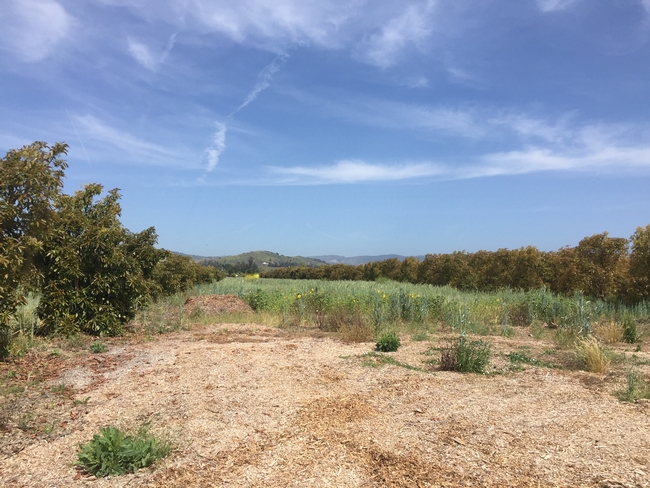
The extremely cool part about Chris's cover cropping is the noticeable change in organic matter and water flow on the ranch. Before he started cover cropping, Chris's soils measured about 2.5% organic matter, which is typical for Ventura County. Since he has been cover cropping, that number has increased to 5.5%. With the increase in organic matter, Chris has seen an increase in porosity, improved infiltration, and decreased runoff.
Cover crops are one strategy to build soil organic matter, increase water infiltration, and reduce greenhouse gas emission on agricultural lands. In addition, they have been shown to improve crop yields, increase biodiversity, attract beneficial pollinators, and act as weed suppressants. You can learn more about the benefits and types of cover crops through the Sustainable Agriculture Research & Education (SARE) learning center. The California Department of Food and Agriculture's Healthy Soils Program provides funding to farmers interested in practices such as cover cropping, alleviating some of the initial costs associated with starting the practice. For more information about cover crops or the Healthy Soils Program, please reach out to me or your closest UC Cooperative Extension community education specialist:
Mendocino County: Britta Baskerville – blbaskerville@ucanr.edu
Glenn County: Dana Brady – dmbrady@ucanr.edu
Yolo County: Emily Lovell – ejlovell@ucanr.edu
Santa Cruz County: Valerie Perez – valperez@ucanr.edu
Ventura County: Alli Rowe – amrowe@ucanr.edu
San Diego County: Esther Mosase – enmosase@ucanr.edu
Imperial County: Kristian Salgado – kmsalgado@ucanr.edu
Kern County: Shulamit Shroder – sashroder@ucanr.edu
Climate smart agriculture encompasses management practices that increase soil carbon sequestration, reduce greenhouse gas emissions, improve yields and efficiencies, and promotes climate resilience. The California Department of Food and Agriculture (CDFA) supports three funding opportunities in climate smart agriculture: the Healthy Soils Program, the State Water Efficiency & Enhancement Program, and the Alternative Manure Management Program.
In a collaborative partnership, CDFA and UC Agriculture and Natural Resources have teamed up to support 10 community education specialists throughout the state to provide technical assistance and outreach for the climate smart agriculture programs. As one of these technical assistance providers, my role is to promote and support the adoption of these programs in Ventura County. If you are interested in working with me, please contact me at amrowe@ucanr.edu
- Author: Alli Rowe
The Nuts and Bolts of Carbon Farming
I recently attended a Carbon Farm Plan Training hosting by Restoration Oaks Ranch, the Cachuma Resource Conservation District, and the Carbon Cycle Institute. I had heard about carbon farm plans and understood the concept, but attending this training gave me a much greater appreciation of what the nitty gritty details of creating one of these plans entails.
In a nutshell, a carbon farm plan takes a look at your farm from a carbon cycling perspective. The management practices that take place on the landscape influence the ins and outs of carbon moving through the system. Land management can push the meter towards increasing carbon into the system or releasing it out of the system. Developing a carbon farm plan creates a blueprint of management practices that lead to a net gain of carbon into the land system.
Agriculture is the one sector that has the ability to change from a net carbon emitter to a net carbon sequesterer. Common agricultural practices such as over-grazing, tilling the soil, over application of chemical fertilizers and pesticides, and mismanaged irrigation can result in carbon emissions, contributing to climate change. Removing carbon through harvesting crops without adequate replacement further depletes the carbon content of the soil. Carbon farming relies on plants doing the thing they do best, photosynthesizing, and maximizes the carbon cycle to result in a net gain of soil carbon. In this way, carbon farming improves the rate that carbon dioxide is removed from the atmosphere and converted to soil carbon or plant tissues, allowing agriculture to act as a net carbon sink. This process builds soil organic matter, which then increases water infiltration, enhances water-holding capacity, improves soil structure, and promotes soil microbiota diversity.
A Carbon Farm Plan is a long-term document created through a process modeled after the Natural Resource Conservation Service (NRCS) Conservation Plan. Local Resource Conservation Districts (RCDs) and agricultural support organizations (such as UC Cooperative Extension) provide the planning support to individual farmers and ranchers when creating a Carbon Farm Plan. The process begins with taking an overall inventory of natural resource conditions on the farm or ranch and generating a list of opportunities for enhanced carbon storage. The list of potential practices are refined based on the management goals of the farmer or rancher. Next, the carbon benefit potential for each practice is quantified using a set of online tools (COMET-Planner and COMET-Farm) developed by Colorado State University, NRCS, Carbon Cycle Institute, and the Marin Carbon Project. Once the list of practices are identified, prioritized, and quantified, a document is generated that lays out a plan of implementation based on funding sources and technical assistance.

What practices might you want to include in a Carbon Farm Plan? The NRCS has described many conservation practices that promote soil carbon sequestration and reduce greenhouse gas emissions. Some of these include:
- Cover cropping
- Compost application
- Reduced till or no till
- Multi-story cropping
- Windbreak and shelterbelt establishment
- Silvopasture establishment
- Forage and biomass planting
- Nutrient management
- Range planting
- Hedgerow planting
- Mulch application
A Carbon Farm Plan creates a road map for managing agricultural and working lands through a carbon lens. However, it also provides a working framework to address many ecosystem co-benefits that affect viability of agriculture in a changing climate. Improvements to soil health increase water holding capacity, soil stability and structural integrity, and decreases nutrient and water runoff. In addition, planting herbaceous and woody plants can sequester carbon while improving pollinator habitat. These practices influence the carbon cycle, but more broadly help agriculture build resiliency to drought, water inconsistencies, and temperature variability as the climate changes.
Let's get (carbon) farming!

Climate smart agriculture encompasses management practices that increase soil carbon sequestration, reduce greenhouse gas emissions, improve yields and efficiencies, and promotes climate resilience. The California Department of Food and Agriculture (CDFA) supports three funding opportunities in climate smart agriculture: the Healthy Soils Program, the State Water Efficiency & Enhancement Program, and the Alternative Manure Management Program.
In a collaborative partnership, CDFA and UC Agriculture and Natural Resources have teamed up to support 10 community education specialists throughout the state to provide technical assistance and outreach for the climate smart agriculture programs. As one of these technical assistance providers, my role is to promote and support the adoption of these programs in Ventura County. If you are interested in working with me, please contact me at amrowe@ucanr.edu.
- Author: Alli Rowe
Hi again!
In my first blog post I introduced myself and shared some information about climate smart agriculture. Today, I'd like to share more about what is being done in California and how that relates to the implementation of practices on the ground. Specifically, I'd like to introduce three programs: Healthy Soils, State Water Efficiency and Enhancement, and Alternative Manure Management.
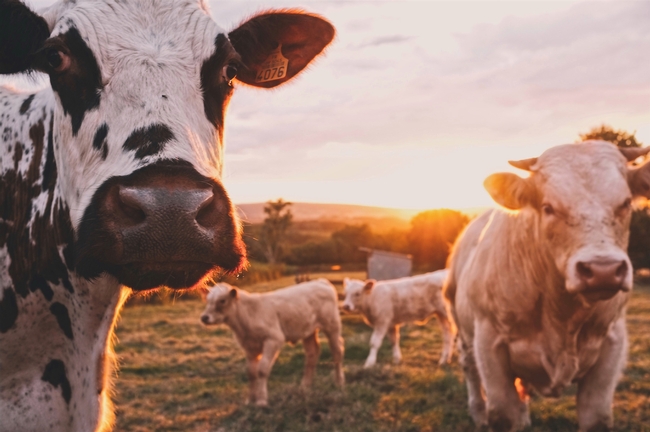
To build resiliency in agriculture and reduce the impacts of climate change, the California Department of Food and Agriculture launched Climate Smart Agriculture Programs in 2014, funding them with proceeds from the state's cap-and-trade program. The programs provide unique grant opportunities to farmers and ranchers to adopt management practices that reduce greenhouse gas emissions, increase carbon storage in soils and woody plants, and improve water use efficiency, all while benefiting the agricultural economy and community.
In my role, I act as a technical assistance provider for these programs in Ventura County. That means I get the word out to farmers and ranchers about the programs, work with folks to develop a project proposal, provide assistance in completing the online application, and support project implementation. If you are a farmer or rancher interested in any of these programs, you can contact me anytime. Serving you is my #1 priority.
The three programs are the following:
Alternative Manure Management Program (AMMP)
- Awards funds to dairy and livestock operations to implement alternative manure management practices that reduce methane emissions.
- Practices include (but are not limited to): solid separation, composting, solid storage, and conversion from flush to scrape.
- Maximum grant size $750,000.
State Water Efficiency & Enhancement Program (SWEEP)
- Awards funds to farmers and ranchers to implement irrigation and pump upgrades that save water and reduce greenhouse gas emissions.
- Practices include (but are not limited to): installation of variable frequency drive, pump upgrades and retrofits, filter installation, soil moisture sensor installation, or converting water delivery methods.
- Maximum grant size $100,000.
- Awards funds to farmers and ranchers to implement practices that build soil health, increase soil carbon, and reduce greenhouse gas emissions.
- Practices include (but are not limited to): cover cropping, mulch application, compost application, nutrient management planning, windbreak or hedgerow establishment, prescribed grazing management, reduced or no till.
- There are two applications available through the Incentives Program or Demonstration Projects.
- The Incentives Program funds implementation of conservation practices. Maximum grant size is $75,000.
- The Demonstration Projects showcase implementation of Healthy Soils practices to farmers and ranchers in the community and can have an additional research component. Maximum grant size without a research project is $100,000 and $250,000 with a research project.
To date, these climate smart agriculture programs have funded over 700 projects on farms and ranches in California. Over the course of the lifetime of the project, they will reduce California's GHG emissions by more than 750,000 metric tons of CO2e, the equivalent of removing approximately 200,000 cars from the road for a year. And that's just the beginning!
These programs are fledglings and require more support to develop into effective funding opportunities for farmers and ranchers. With time and resources, climate smart agriculture programs have enormous potential to build resiliency for California farmers and ranchers while reducing GHG emissions, saving water, and storing carbon in our soils.
There are currently 8 community education specialists working throughout the state as technical assistance providers for these programs. If you are located outside of Ventura County and are interested in applying for a grant or have questions, please contact the UC Extension community education specialist in your region.
Mencino County: Britta Baskerville – blbaskerville@ucanr.edu
Glenn County: Dana Brady – dmbrady@ucanr.edu
Yolo County: Emily Lovell – ejlovell@ucanr.edu
Santa Cruz County: Valerie Perez – valperez@ucanr.edu
Ventura County: Alli Rowe – amrowe@ucanr.edu
San Diego County: Esther Mosase – enmosase@ucanr.edu
Imperial County: Kristian Salgado – kmsalgado@ucanr.edu
Kern County: Shulamit Shroder – sashroder@ucanr.edu

Climate smart agriculture encompasses management practices that increase soil carbon sequestration, reduce greenhouse gas emissions, improve yields and efficiencies, and promotes climate resilience. The California Department of Food and Agriculture (CDFA) supports three funding opportunities in climate smart agriculture: the Healthy Soils Program, the State Water Efficiency & Enhancement Program, and the Alternative Manure Management Program.
In a collaborative partnership, CDFA and UC Agriculture and Natural Resources have teamed up to support 10 community education specialists throughout the state to provide technical assistance and outreach for the climate smart agriculture programs. As one of these technical assistance providers, my role is to promote and support the adoption of these programs in Ventura County. If you are interested in working with me, please contact me at amrowe@ucanr.edu.
- Author: Alli Rowe
Hello!
My name is Alli Rowe, Ventura County UC Cooperative Extension's Community Education Specialist working to promote and expand the adoption of science-based climate smart farming and ranching practices. I bring a background in biology, research experience on working lands and climate change, and enthusiasm for supporting food systems. Plus, I really like to talk about soil carbon. Like a lot.
Now, what exactly is climate smart agriculture? The Food and Agriculture Organization of the United Nations coined the term climate smart agriculture as “an approach that helps to guide actions needed to transform and reorient agricultural systems to effectively support development and ensure food security in a changing climate”. In short, climate smart agriculture addresses how to manage agricultural systems to meet the nutritional needs of a growing population while both building resiliency to climate change and using agriculture as a solution to our climate crisis.
To be effective, climate smart agriculture must meet three main objectives:
1) Increase agricultural productivity and incomes;
2) Adapt to and build resiliency to climate change; and
3) Reduce greenhouse gas emissions
Climate smart agriculture addresses the risks that agricultural production faces under a changing climate, underscores agriculture's role in solving climate change, and focuses on the importance of intensification of agriculture required to feed a global population.
California's agricultural industry is at extreme risk to the impacts of climate change. Changes in temperatures, precipitation patterns, extreme weather events, and water availability all pose a threat to the viability of agricultural production. Warming temperatures throughout the state will result in a decline of winter chill hours, increased water demand by crops, and the promotion of various pests. Projections show an increased tendency of heat wave events and an increase in duration and intensity of drought. In addition, California expects to see earlier snowmelt, resulting in increased flooding and a decrease in year-round water availability. This is a doom and gloom scenario we look towards unless we decide to act today to plan for tomorrow.
Agriculture and working lands play a significant role in climate change. According to the EPA's recent inventory, agricultural management practices contribute 8.4% of the United States' greenhouse gas (GHG) emissions. Interestingly, and encouragingly, agriculture can also act as a greenhouse gas sink by removing atmospheric carbon and storing it in plant tissue and soils. Through effective management, agriculture provides a significant solution to climate change.
This means agriculture can build resiliency to the impacts of climate change while acting as a solution to climate change. Carbon sequestration (long-term storage) in our soils is a low-tech solution that has been around since plants started photosynthesizing. Climate smart agriculture management practices focus on building soil health, increasing carbon storage in woody plants and soil, improving water use efficiency, and reducing greenhouse gas emissions associated with agricultural practices.
While climate smart agriculture practices are important to building resiliency and addressing climate change, they also tackle the essential questions of agricultural productivity. In order to feed a growing global population, existing agricultural production must be intensified. This means getting the maximum yields out of land already under cultivation so we don't go tearing out more carbon-rich forests to expand mediocre agricultural lands. Increasing soil health and hyper-efficiently managing water improves yields and reduces the cost of inputs such as fertilizer and water. Farming for a climate-smart future means farming to feed the world and keeping farmers farming.
My work centers around identifying management practices that boost agricultural productivity, save money on synthetic inputs and expensive water, build resilience to a changing climate and combat the increasing carbon emissions in our atmosphere. I look forward to sharing what farmers and ranchers are doing in Ventura County and beyond in future blog posts!
Climate smart agriculture encompasses management practices that increase soil carbon sequestration, reduce greenhouse gas emissions, improve yields and efficiencies, and promotes climate resilience. The California Department of Food and Agriculture (CDFA) supports three funding opportunities in climate smart agriculture: the Healthy Soils Program, the State Water Efficiency & Enhancement Program, and the Alternative Manure Management Program.
In a collaborative partnership, CDFA and UC Agriculture and Natural Resources have teamed up to support 10 community education specialists throughout the state to provide technical assistance and outreach for the climate smart agriculture programs. As one of these technical assistance providers, my role is to promote and support the adoption of these programs in Ventura County. If you are interested in working with me, please contact me at amrowe@ucanr.edu.




